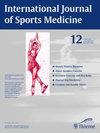Serum metabolome signature response to different types of resistance training.
IF 2
4区 医学
Q2 SPORT SCIENCES
引用次数: 0
Abstract
Pneumatic resistance training (PRT) facilitates a longer time under tension that might lead to greater changes in body composition when compared to traditional resistance training (TRT), possibly enhancing serum metabolite concentrations indicative of healthy metabolic function. To assess the impact of PRT and TRT on muscular strength, body composition and serum metabolome, sixty-nine men (age: 31.8±7.2 years, height: 179.7±5.4 cm, weight: 81.1±9.9 kg) were randomized into two 10-week intervention groups (PRT:n=24 and TRT:n=24) and one control group (CON:n=21). Serum metabolite concentrations were assessed before and after the training intervention by high-throughput nuclear magnetic resonance. Fat mass and lean mass were obtained by bioimpedance analysis. The training intervention resulted in an increase in LM for both PRT (1.85 ± 2.69%; p=0.003) and TRT (2.72 ±4.53%; p=0.004), while only PRT reduced in body fat percentage (PRT: -5.08±10.76%; p=0.019) statistically significantly. Only in PRT and TRT significant increases in small high-density lipoproteins (S-HDL-L) and small HDL particles (S-HDL-P) were observed. When controlling for fat and lean mass, the effects on S-HDL-L/S-HDL-P diminished. Network analysis may suggest that PRT and TRT result in an increase in network connectivity and robustness. It appears that the observed improvements are associated with changes in body composition.血清代谢组特征对不同类型阻力训练的反应。
与传统阻力训练(TRT)相比,气动阻力训练(PRT)有助于延长在张力作用下的时间,这可能会导致身体成分发生更大的变化,并有可能提高血清代谢物浓度,从而促进健康的新陈代谢功能。为了评估 PRT 和 TRT 对肌肉力量、身体成分和血清代谢组的影响,69 名男性(年龄:31.8±7.2 岁,身高:179.7±5.4 厘米,体重:81.1±9.9 千克)被随机分为两个为期 10 周的干预组(PRT:24 人;TRT:24 人)和一个对照组(CON:21 人)。通过高通量核磁共振对训练干预前后的血清代谢物浓度进行评估。通过生物阻抗分析获得脂肪量和瘦肉量。训练干预导致 PRT(1.85±2.69%;p=0.003)和 TRT(2.72±4.53%;p=0.004)的瘦肉率增加,而只有 PRT 的体脂率(PRT:-5.08±10.76%;p=0.019)有显著的统计学降低。只有在 PRT 和 TRT 中观察到小高密度脂蛋白(S-HDL-L)和小高密度脂蛋白颗粒(S-HDL-P)明显增加。如果控制脂肪和瘦体重,对 S-HDL-L/S-HDL-P 的影响会减弱。网络分析可能表明,PRT 和 TRT 增加了网络的连通性和稳健性。观察到的改善似乎与身体成分的变化有关。
本文章由计算机程序翻译,如有差异,请以英文原文为准。
求助全文
约1分钟内获得全文
求助全文
来源期刊
CiteScore
4.80
自引率
4.00%
发文量
111
审稿时长
3-8 weeks
期刊介绍:
The IJSM provides a forum for the publication of papers dealing with both basic and applied information that advance the field of sports medicine and exercise science, and offer a better understanding of biomedicine. The journal publishes original papers, reviews, short communications, and letters to the Editors.

 求助内容:
求助内容: 应助结果提醒方式:
应助结果提醒方式:


